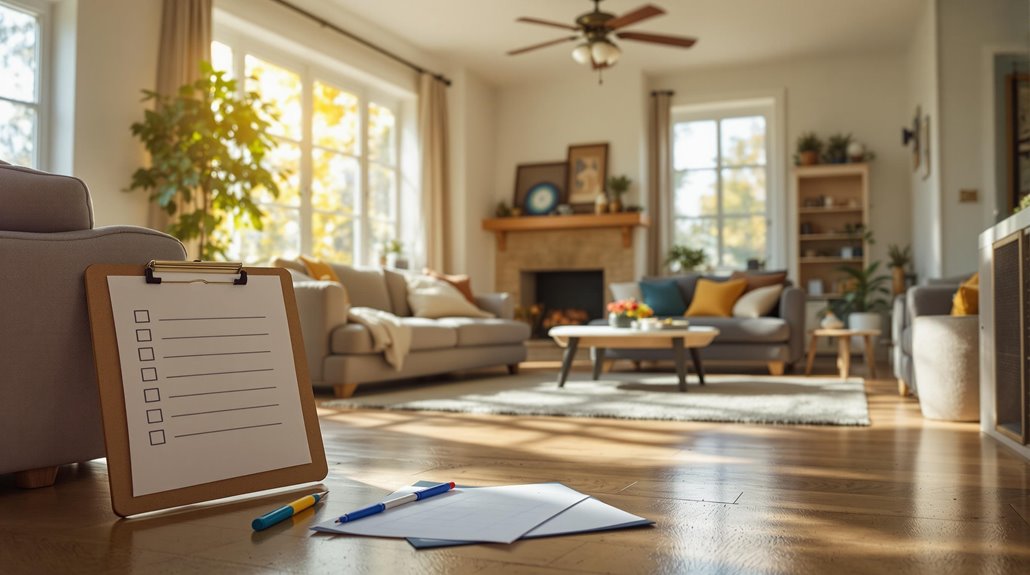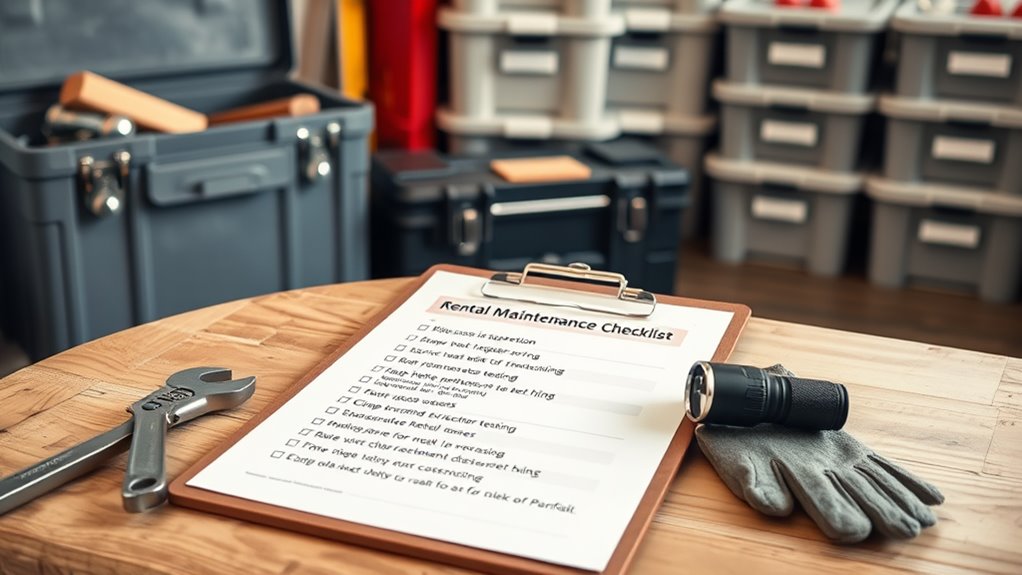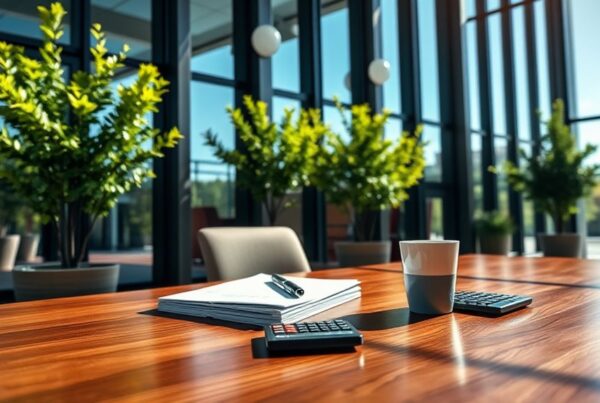Start by testing smoke and carbon monoxide detectors monthly and replacing batteries as needed. Inspect fire extinguishers and security systems regularly to guarantee safety. Conduct seasonal outdoor tasks like clearing gutters, trimming trees, and checking the roof for damage. Inside, replace HVAC filters every 90 days and inspect plumbing fixtures to prevent leaks. Budget wisely using the 1% Rule and prioritize preventative rental property Maintenance. Communicate clearly with tenants to address issues promptly. Explore more strategies to keep your property in top shape year-round.
Key Takeaways
- Schedule annual inspections for fire sprinkler systems, HVAC, and plumbing to ensure safety and functionality.
- Test smoke and carbon monoxide detectors monthly and replace batteries as needed for continuous tenant safety.
- Inspect roofs, gutters, and outdoor lighting seasonally to prevent damage and maintain property security.
- Budget for maintenance using the 1% Rule, saving 1% of the property’s value annually for upkeep.
- Establish a clear communication system for tenants to report maintenance issues with detailed descriptions and photos.
Essential Safety Rental Property Maintenance
Before renting out a property, it’s vital to prioritize safety by conducting regular checks on all important systems. Start by testing Smoke and Carbon Monoxide detectors monthly to confirm they’re functioning and replace batteries as needed. Inspect Fire Extinguishers monthly for accessibility, charge, and expiration dates, replacing any that are compromised. If your property has a fire sprinkler system, schedule Annual Maintenance with a professional to guarantee Compliance with local safety standards. Security Alarms, cameras, and motion sensors should also undergo routine Inspections to verify they’re operational and deter potential threats. Maintain detailed Documentation of all safety system checks and Maintenance activities, as this supports Property Management efforts and guarantees accountability. Proactive Safety measures not only protect tenants but also reduce liability and confirm Compliance with regulations. Regularly updating and reviewing these systems is essential for maintaining a secure and well-managed rental property. Using accounting software can streamline the Documentation process, ensuring all safety checks and maintenance activities are accurately recorded and easily accessible.
Seasonal Outdoor Maintenance Tasks
As seasons change, staying on top of outdoor maintenance guarantees your rental property remains safe, functional, and visually appealing. Start by inspecting the roof for damage and debris, such as loose or missing shingles, to prevent leaks and water damage. Clear gutters and downspouts to confirm proper drainage and avoid water backup that could lead to flooding. Trim trees and bushes seasonally to eliminate hazards like falling limbs and maintain clear access to the property. Before winter hits, winterize outdoor spigots by disconnecting hoses, draining water, and turning off the supply to prevent frozen pipes. Regularly inspect outdoor lighting fixtures to confirm they’re operational, replacing burnt-out bulbs to enhance visibility and security. Property owners should integrate these tasks into their maintenance checklists to address potential issues proactively. Seasonal maintenance protects your investment and keeps tenants safe year-round. Conducting a Market Rent Analysis can help property owners set competitive rental prices while maintaining property value.
Indoor Maintenance Tips for Year-Round Care

To maintain your rental property effectively, prioritize year-round indoor maintenance to prevent costly repairs and assure tenant safety. Start by adding indoor maintenance tips to your Property Maintenance Checklists to stay organized and proactive. Regularly test smoke and carbon monoxide detectors, and replace batteries as needed. If you have a fire sprinkler system, schedule professional inspections and maintenance annually. For your HVAC system, replace air filters every 90 days to guarantee efficiency and improve indoor air quality. Annually flush water heaters to remove sediment buildup and check for leaks. Utilize property management software to streamline maintenance tracking and ensure timely repairs. Inspect plumbing fixtures and pipes for corrosion or leaks to prevent Water Damage Around sinks and showers. Refresh caulking and grout in bathrooms to combat mold and check for Signs Of Wear. Encourage tenants to report any issues promptly, as outlined in the lease agreement. These preventive maintenance steps will keep your Annual Rental Property in top condition.
Budgeting Strategies for Property Upkeep
While managing a rental property, implementing effective budgeting strategies for upkeep guarantees financial stability and safeguards your investment. Start by applying the 50% Rule, allocating half of your rental income to operating costs, including maintenance, to guarantee financial sustainability. Additionally, use the 1% Rule to estimate annual maintenance costs, setting aside at least 1% of the property’s value for repairs. For a more precise calculation, follow the Square Footage Rule, budgeting $1 per square foot for annual maintenance. Older properties often require higher allocations due to increased wear and tear, so adjust your budget accordingly. Prioritize savings for unexpected, costly repairs to avoid financial strain. Incorporate a preventative maintenance checklist into your routine to address minor issues before they escalate. By planning ahead and adhering to these budgeting strategies, you’ll maintain your rental property’s condition, minimize disruptions, and protect your long-term returns. Utilizing tools like the Long Term Rental Calculator can further enhance your financial projections and ensure informed investment decisions.
Communication Tips for Tenant Maintenance Requests

Effective communication with tenants about maintenance requests guarantees timely resolutions and fosters positive landlord-tenant relationships. Start by establishing a clear communication policy that outlines how tenants should report maintenance issues, whether through email, phone calls, or maintenance request forms. Encourage tenants to provide detailed descriptions of the problem, including specific locations and any relevant photos, to streamline the troubleshooting process. Clearly communicate your response times, so tenants know when they’ll hear back or when work will be scheduled. After resolving maintenance issues, follow up to confirm tenant satisfaction and address any lingering concerns. Invite feedback on the maintenance process to improve responsiveness and strengthen property management practices. By maintaining open dialogue and setting expectations, you’ll enhance tenant satisfaction and guarantee maintenance requests are handled efficiently. Implementing a long-term rental CRM can further streamline communication and ensure all maintenance requests are tracked and resolved promptly.
Conclusion
Treat rental property maintenance like tending a garden—neglect it, and small issues grow into costly problems. A 2022 survey found landlords who followed annual checklists saved 30% on repairs. Stay proactive: inspect safety systems, tackle seasonal tasks, and address tenant concerns promptly. Budget wisely to avoid financial weeds choking your investment. Regular care keeps your property thriving, just as water and sunlight nurture a flourishing garden. Consistent effort yields long-term rewards.




